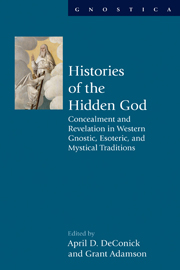 Histories of the Hidden God
Histories of the Hidden God from Part II - The Human Quest for the Hidden God
In this essay I offer a treatment of the concept of revelation in the Sethian literature from Nag Hammadi, in particular as a designation for the movement from “hidden” to “revealed” or “manifest” in two contexts. First, as the transmission of some kind of cognitive content or ritual action essential to the enlightenment and salvation of the recipient, and second as a fundamental ontogenetic concept in the protological metaphysics and mystical epistemology of Sethian and related literature in the first several centuries of the common era.
In the first part of this essay, I treat the notion of revelation as an epistemological category, as the transmission of discursive information – even though it is sometimes said to be “ineffable” and “unknowable” – with special attention to the Trimorphic Protennoia, and in the second part, I explore revelation or “manifestation” mainly as an ontogenetic concept, but also in the epistemological context of mystical union with the primordial source of all reality in the Sethian Platonizing treatises Zostrianos and Allogenes. It turns out the latter revelation is a form of self-knowledge and knowledge of God that is entirely devoid of cognitive content.
To save this book to your Kindle, first ensure [email protected] is added to your Approved Personal Document E-mail List under your Personal Document Settings on the Manage Your Content and Devices page of your Amazon account. Then enter the ‘name’ part of your Kindle email address below. Find out more about saving to your Kindle.
Note you can select to save to either the @free.kindle.com or @kindle.com variations. ‘@free.kindle.com’ emails are free but can only be saved to your device when it is connected to wi-fi. ‘@kindle.com’ emails can be delivered even when you are not connected to wi-fi, but note that service fees apply.
Find out more about the Kindle Personal Document Service.
To save content items to your account, please confirm that you agree to abide by our usage policies. If this is the first time you use this feature, you will be asked to authorise Cambridge Core to connect with your account. Find out more about saving content to Dropbox.
To save content items to your account, please confirm that you agree to abide by our usage policies. If this is the first time you use this feature, you will be asked to authorise Cambridge Core to connect with your account. Find out more about saving content to Google Drive.